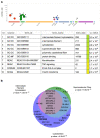Is IIIG9 a New Protein with Exclusive Ciliary Function? Analysis of Its Potential Role in Cancer and Other Pathologies
- PMID: 36291193
- PMCID: PMC9600092
- DOI: 10.3390/cells11203327
Is IIIG9 a New Protein with Exclusive Ciliary Function? Analysis of Its Potential Role in Cancer and Other Pathologies
Abstract
The identification of new proteins that regulate the function of one of the main cellular phosphatases, protein phosphatase 1 (PP1), is essential to find possible pharmacological targets to alter phosphatase function in various cellular processes, including the initiation and development of multiple diseases. IIIG9 is a regulatory subunit of PP1 initially identified in highly polarized ciliated cells. In addition to its ciliary location in ependymal cells, we recently showed that IIIG9 has extraciliary functions that regulate the integrity of adherens junctions. In this review, we perform a detailed analysis of the expression, localization, and function of IIIG9 in adult and developing normal brains. In addition, we provide a 3D model of IIIG9 protein structure for the first time, verifying that the classic structural and conformational characteristics of the PP1 regulatory subunits are maintained. Our review is especially focused on finding evidence linking IIIG9 dysfunction with the course of some pathologies, such as ciliopathies, drug dependence, diseases based on neurological development, and the development of specific high-malignancy and -frequency brain tumors in the pediatric population. Finally, we propose that IIIG9 is a relevant regulator of PP1 function in physiological and pathological processes in the CNS.
Keywords: IIIG9; adherens junctions; ciliopathies; ependymal cells; ependymoma; hydrocephaly; protein phosphatase 1.
Conflict of interest statement
The authors declare no conflict of interest.
Figures





References
-
- Nucleotide [Internet] Bethesda (MD): National Library of Medicine (US), National Center for Biotechnology Information [1988]. Accession No. NM_145017.3, NM_001170753.2, Homo Sapiens Protein Phosphatase 1 Regulatory Subunit 32 (PPP1R32), mRNA. [(accessed on 10 June 2022)]; Available online: https://www.ncbi.nlm.nih.gov/nuccore/NM_145017.3,NM_001170753.2.
-
- Nucleotide [Internet] Bethesda (MD): National Library of Medicine (US), National Center for Biotechnology Information [1988]. Accession No. NM_133689.2, NM_001368184.1, XM_006527302.5, XM_017318281.1, XM_017318282.1, XM_036161672.1, Mus Musculus Protein Phosphatase 1 Regulatory Subunit 32 (Ppp1r32), mRNA. [(accessed on 10 June 2022)]; Available online: https://www.ncbi.nlm.nih.gov/nuccore/NM_133689.2,NM_001368184.1,XM_00652....
Publication types
MeSH terms
Substances
LinkOut - more resources
Full Text Sources
Medical
Molecular Biology Databases

